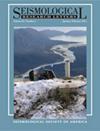地震和次声数据质量指标的无监督机器学习聚类
IF 3.2
3区 地球科学
Q2 GEOCHEMISTRY & GEOPHYSICS
引用次数: 0
摘要
开发改进质量控制(QC)计划的技术,以发现地震和次声数据缺陷,仍然是一个积极的研究领域。为数据质量(DQ)检查自动化选择通用阈值是发现质量控制问题的有效方法,但这些阈值可能无法很好地适用于具有不同 DQ 特征的多个台站。此外,这些阈值可能无法捕捉到数据质量参数的细微变化,而这些变化仍然表明存在问题。机器学习是诊断质量控制问题的另一种方法。K 均值聚类是一种无监督的机器学习聚类算法,过去曾有效地用于地球物理模式探索。本研究通过对从核爆监测数据全天片段中得出的 DQ 指标进行聚类,进一步将 K-means 应用于 DQ 分析。我们在宽带地震仪 DQ 指标上实施的 k-means 分别聚类了大规模近期地震、持续至少一小时的校准和没有校准的天数。将这一技术应用于次声 DQ 指标时,发现了与台站物理问题有关的聚类,如背量螺钉缺失和端口管道入口浸水。这些都是质量控制问题的例子,很难通过度量阈值或检查波形和频谱来诊断或检测。我们的研究结果表明,k 均值聚类是一种有用的质量控制工具,可用于探索 DQ 模式,帮助分析师审查电站的运行和维护情况。从这种探索中学到的知识可以为阈值处理工作流程提供信息,指导如何对各个台站进行量身定制,或者 k-means 模型可以直接对数据进行分类。本文章由计算机程序翻译,如有差异,请以英文原文为准。
Unsupervised Machine Learning Clustering of Seismic and Infrasound Data Quality Metrics
Developing techniques for improving quality control (QC) schemes to catch seismic and infrasound data defects continues to be an area of active research. Selecting universal thresholds for the automation of data quality (DQ) checks is an efficient way to find QC issues, but these thresholds may not apply well to multiple stations with varying DQ characteristics. In addition, these thresholds may not catch subtle changes in DQ parameters that still indicate problems. Machine learning can be an alternative way of diagnosing QC issues. K-means clustering, an unsupervised machine learning clustering algorithm, has been effectively used in the past for geophysical pattern exploration. This study furthers k-means applications to DQ analysis through clustering on DQ metrics derived from day-long segments of nuclear explosion monitoring data. Our k-means implementation on broadband seismometer DQ metrics separately clustered mass recenters, calibrations lasting at least one hour, and days without either. Applying this technique to infrasound DQ metrics revealed clusters related to physical issues at the stations, such as missing back volume screws and the flooding of ported pipe inlets. These are both examples of QC issues that are difficult to diagnose or detect through the thresholding of metrics or by inspecting waveforms and spectra. Our results show that k-means clustering can be a useful QC tool in exploring DQ patterns to assist analyst review of station operation and maintenance. The learned knowledge from this exploration can then inform a thresholding workflow on how to tailor to individual stations, or the k-means model could classify data directly.
求助全文
通过发布文献求助,成功后即可免费获取论文全文。
去求助
来源期刊

Seismological Research Letters
地学-地球化学与地球物理
CiteScore
6.60
自引率
12.10%
发文量
239
审稿时长
3 months
期刊介绍:
Information not localized
 求助内容:
求助内容: 应助结果提醒方式:
应助结果提醒方式:


